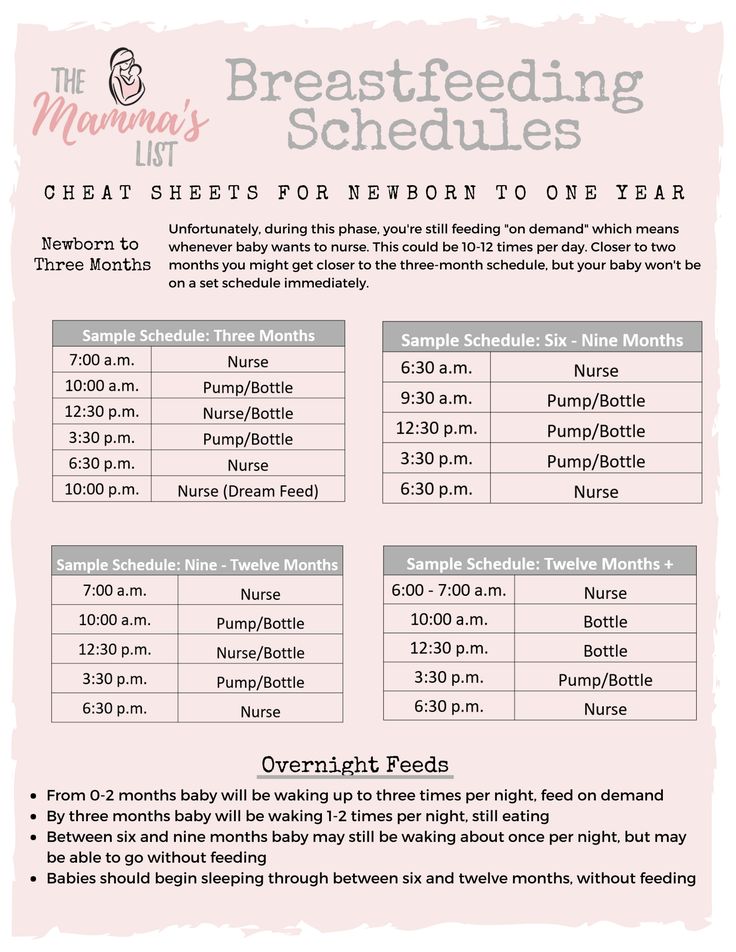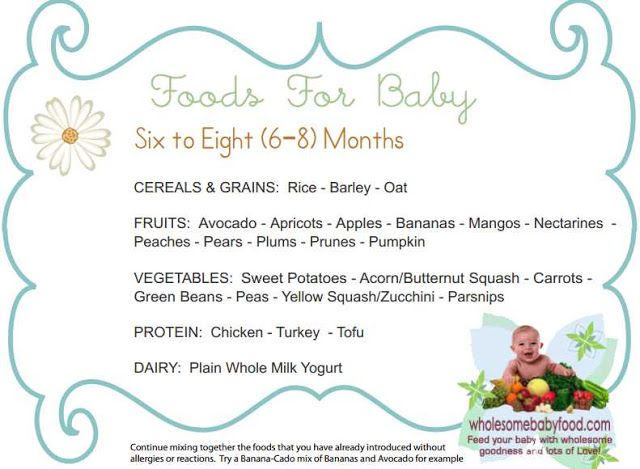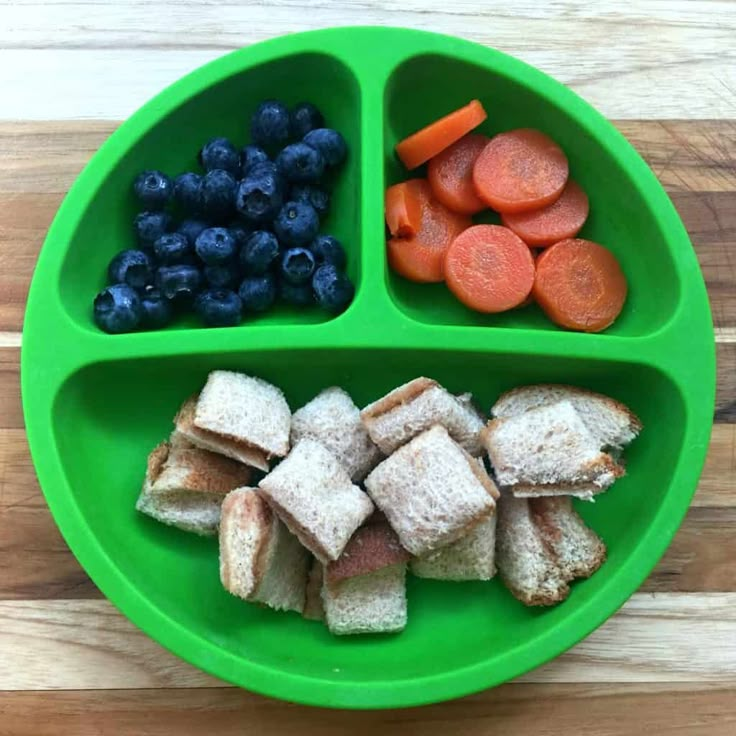Feeding time schedule for babies
How Often and How Much Should Your Baby Eat?
By: Sanjeev Jain, MD, FAAP
One of the most common questions new parents have is how often their baby should eat. The best answer is surprisingly simple: in general, babies should be fed whenever they seem hungry.
How do I know when my baby is hungry?
For babies born
prematurely or with certain medical conditions, scheduled feedings advised by your pediatrician are best. But for most healthy, full-term infants, parents can look to their baby rather than the clock for hunger cues. This is called feeding on demand, or
responsive feeding.
Hunger cues
A hungry baby often will cry. But it's best to watch for hunger cues before the baby starts crying, which is a late sign of hunger and can make it hard for them to settle down and eat.
Some other typical hunger cues in babies:
Licking lips
Sticking tongue out
Rooting (moving jaw and mouth or head in search of breast)
Putting his/her hand to mouth repeatedly
Opening her mouth
Fussiness
Sucking on everything around
It is important to realize, however, that every time your baby cries or sucks it is not necessarily because he or she is hungry. Babies suck not only for hunger, but also for comfort; it can be hard at first for parents to tell the difference. Sometimes, your baby just needs to be cuddled or changed.
General guidelines for baby feeding
It is important to remember all babies are different―some like to snack more often, and others drink more at one time and go longer between feedings. However, most babies will drink more and go longer between feedings as they get bigger and their tummies can hold more milk:
Most newborns eat every 2 to 3 hours, or 8 to 12 times every 24 hours. Babies might only take in half ounce per feeding for the first day or two of life, but after that will usually drink 1 to 2 ounces at each feeding. This amount increases to 2 to 3 ounces by 2 weeks of age.
At about 2 months of age, babies usually take 4 to 5 ounces per feeding every 3 to 4 hours.
At 4 months, babies usually take 4 to 6 ounces per feeding.
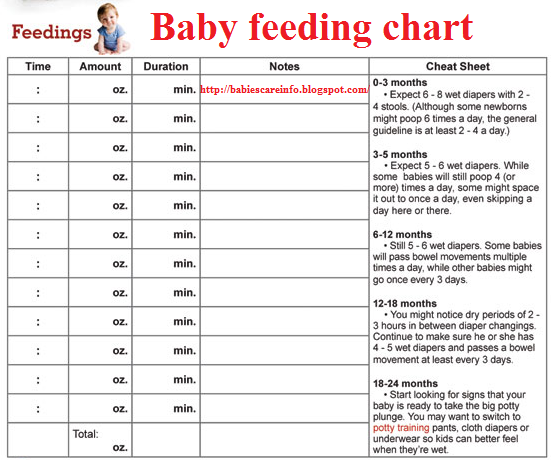
At 6 months, babies may be taking up to 8 ounces every 4 to 5 hours.
Most babies will increase the amount of formula they drink by an average of 1 ounce each month before leveling off at about 7 to 8 ounces per feeding. Solid foods should be started at about 6 months old.
Concerns about overfeeding or underfeeding your baby
Too full?
Babies are usually pretty good at eating the right amount, but they can sometimes take in more than they need. Infants who are bottle feeding may be more likely to overfeed, because drinking from a bottle may take less effort than breastfeeding.
Overfed babies can have stomach pains, gas, spit up or vomit and be at higher risk for obesity later in life. It's better to offer less, since you can always give more if your baby wants it. This also gives babies time to realize when they're full.
If you are concerned your baby wants to eat
all the time―even when he or she is full―talk with your pediatrician.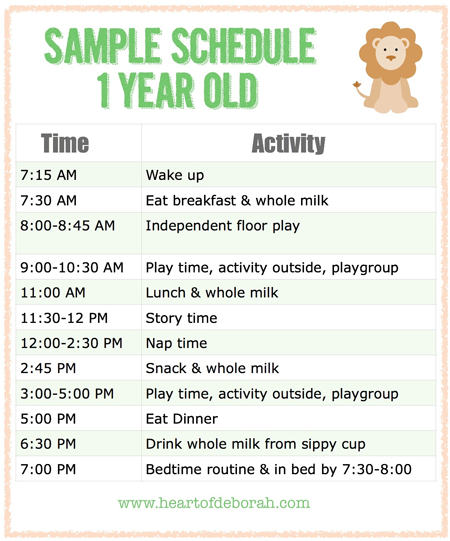 Pacifiers may be used after feeding to help sooth healthy-weight babies who like to suck for comfort, rather than nutrition. For babies who are breastfed, it's best to wait to offer pacifiers until around 3 to 4 weeks of age, when breastfeeding is well-established.
Pacifiers may be used after feeding to help sooth healthy-weight babies who like to suck for comfort, rather than nutrition. For babies who are breastfed, it's best to wait to offer pacifiers until around 3 to 4 weeks of age, when breastfeeding is well-established.
Trouble gaining weight?
Most babies will double their birth weight by 5 months of age and triple their birth weight by their first birthday. If your baby is having trouble gaining weight, don't wait too long between feeding―even if it means waking your baby. Be sure to talk with your pediatrician about how often and how much to feed your baby.
How do I know if my baby is getting enough to eat?
Daily diapers
A newborn's
diaper is a good indicator of whether he or she is getting enough to eat. In the first few days after birth, a baby should have 2 to 3 wet diapers each day. After the first 4 to 5 days, a baby should have at least 5 to 6 wet diapers a day. Stool frequency is more variable and depends whether your baby is
breastfed or formula fed.
Growth charts
During regular health check-ups, your pediatrician will check your baby's weight and plot it on a growth chart. Your baby's progress on the growth chart is one way to tell whether or not they are getting enough food. Babies who stay in healthy growth percentile ranges are probably getting a healthy amount of food during feedings.
Remember
Talk with your pediatrician if you have any questions or concerns about your baby getting the right amount to eat.
More information:
- Making Sure Your Baby is Getting Enough Milk
- Amount and Schedule of Formula Feedings
- Is Your Baby Hungry or Full? Responsive Feeding Explained (Video)
- Remedies for Spitty Babies
- Ask the Pediatrician: With the baby formula shortage, what should I do if I can't find any?
- Ask the Pediatrician: How should we feed our baby if we're running low on money?
-
Airplane Choo Choo: A Feeding Guide for Children (National Dairy Council)
About Dr.
 Jain:
Jain:
Sanjeev Jain, MD, FAAP, is a Clinical Associate Professor of General Pediatrics and Adolescent Medicine at the University of Wisconsin School of Medicine and Public Health. Within the American Academy of Pediatrics, he is a member of the Section on International Child Health and the Wisconsin State Chapter.
The information contained on this Web site should not be used as a substitute for the medical care and advice of your pediatrician. There may be variations in treatment that your pediatrician may recommend based on individual facts and circumstances.
Tips for the First Year
Eat, sleep, pee, poop, repeat. Those are the highlights in a day of the life of a brand new baby.
And if you’re a new parent, it’s the eating part that may be the source of many of your questions and worries. How many ounces should your baby take? Do you wake a sleeping baby to eat? Why do they seem hungry all the time? When can your child start solids?
Questions abound — and, despite Grandma’s insistence, the answers have changed since you were a tot.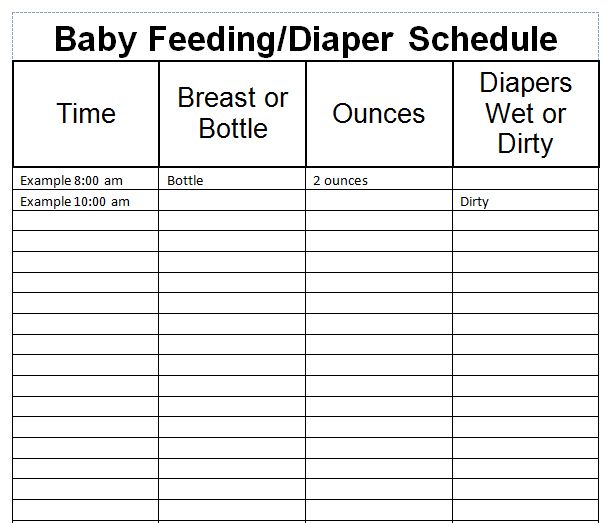 It’s now recommended that newborns, even formula-fed ones, eat on demand (consider it good preparation for the teenage years) and that babies wait to start solid foods until they’re 4 to 6 months old.
It’s now recommended that newborns, even formula-fed ones, eat on demand (consider it good preparation for the teenage years) and that babies wait to start solid foods until they’re 4 to 6 months old.
On day one of life, your baby’s stomach is the size of a marble and can only hold 1 to 1.4 teaspoons of liquid at a time. As your baby gets older, their stomach stretches and grows.
It’s hard (or impossible, really) to know how much milk your baby is taking in while breastfeeding. But if you’re bottle feeding due to any number of valid reasons, it’s a bit easier to measure.
Here, from the American Academy of Pediatrics (AAP), a typical feeding schedule for bottle-fed babies.
| Age | Ounces per feeding | Solid foods |
|---|---|---|
| Up to 2 weeks of life | .5 oz. in the first days, then 1–3 oz. | No |
| 2 weeks to 2 months | 2–4 oz. | No |
| 2–4 months | 4-6 oz. | No |
| 4–6 months | 4–8 oz. | Possibly, if your baby can hold their head up and is at least 13 pounds. But you don’t need to introduce solid foods yet. |
| 6–12 months | 8 oz. | Yes. Start with soft foods, like one-grain cereals and pureed vegetables, meats, and fruits, progressing to mashed and well-chopped finger foods. Give your baby one new food at a time. Continue supplementing with breast or formula feedings. |
Every baby is unique — but one thing that’s pretty consistent is that breastfed babies eat more frequently than bottle-fed ones. That’s because breast milk is easily digested and empties from the stomach a lot quicker than formula.
Breastfed babies
There’s no rest for the weary. According to La Leche League International, you should begin nursing your baby within 1 hour of birth and provide about 8 to 12 feedings daily in the first few weeks of life (yeah, we’re exhausted for you).
At first, it’s important not to let your baby go more than 4 hours without feeding. You’ll likely need to wake them up if necessary, at least until breastfeeding is well established and they’re gaining weight appropriately.
As your baby grows and your milk supply amps up, your baby will be able to take in more milk in less time at one feeding. That’s when you might start to notice a more predictable pattern.
- 1 to 3 months: Your baby will feed 7 to 9 times per 24 hours.
- 3 months: Feedings take place 6 to 8 times in 24 hours.
- 6 months: Your baby will feed around 6 times a day.
- 12 months: Nursing may drop to about 4 times a day. The introduction of solids at about 6 months helps to fuel your baby’s additional nutritional needs.
Keep in mind that this pattern is just one example. Different babies have different paces and preferences, along with other factors that influence the frequency of feedings.
Bottle-fed babies
Like breastfed babies, bottle-fed newborns should eat on demand. On average, that’s about every 2 to 3 hours. A typical feeding schedule may look like this:
On average, that’s about every 2 to 3 hours. A typical feeding schedule may look like this:
- Newborn: every 2 to 3 hours
- At 2 months: every 3 to 4 hours
- At 4 to 6 months: every 4 to 5 hours
- At 6+ months: every 4 to 5 hours
For both breastfed and bottle-fed babies
- Don’t give liquids other than formula or breast milk to babies under a year old. That includes juices and cow’s milk. They don’t provide the right (if any) nutrients and can be upsetting to your baby’s tummy. Water can be introduced around 6 months when you start offering a cup.
- Don’t add baby cereal to a bottle.
- It can create a choking hazard.
- A baby’s digestive system isn’t mature enough to handle cereal until about 4 to 6 months of age.
- You could overfeed your baby.
- Don’t give your baby any form of honey until after their first birthday. Honey can be dangerous for a baby, occasionally causing what’s called infant botulism.
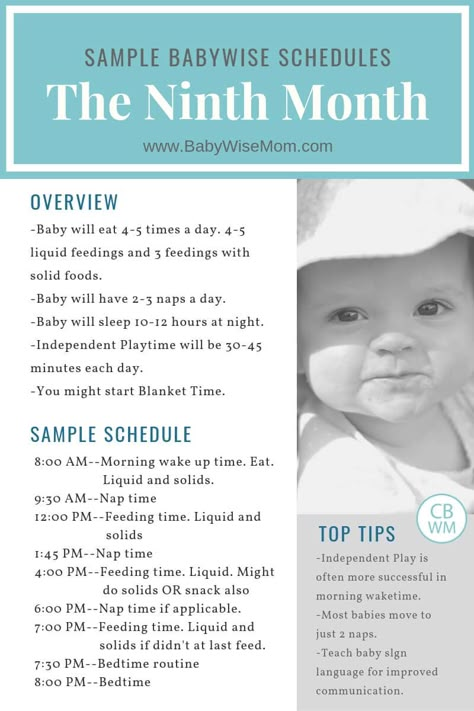
- Do adjust your expectations based on your baby and their unique needs. Premature babies are likely to follow feeding patterns according to their adjusted age. If your baby has challenges like reflux or failure to thrive, you may need to work with your doctor on the appropriate feeding schedule and amount they should be eating.
Schedules are the holy grail of every parent. Your child will naturally start to fall into a feeding pattern as their tummy grows and they can take in more breast milk or formula at one sitting. This may begin to happen between 2 and 4 months of age.
For now, though, focus on learning your baby’s hunger cues, such as:
- rooting around your chest, looking for a nipple.
- putting their fist in their mouth
- smacking or licking their lips
- fussing that can escalate quickly (don’t wait until your baby’s hangry to feed them)
Once your baby is a few months old, you may be able to introduce a sleep/feed schedule that works for you.
Let’s say, for example, your 4-month-old wakes every 5 hours for a feeding. That means if you feed at 9 p.m., your baby wakes around 2 a.m. But if you wake and feed the baby at 11 p.m., just before you go to bed, they may not rouse until 4 a.m., giving you a decent chunk of nighttime winks.
In general, if your baby seems hungry, feed them. Your baby will naturally eat more frequently during growth spurts, which typically occur around 3 weeks, 3 months, and 6 months of age.
Some babies will also “cluster feed,” meaning they’ll feed more frequently during certain periods and less at others. For example, your baby may cluster feed during the late afternoon and evening and then sleep longer at night (yay!). This is more common in breastfed babies than bottle fed babies.
Worried about overfeeding? While this isn’t really possible to do with an exclusively breastfed baby, you can overfeed a baby who’s taking a bottle — especially if they’re sucking on the bottle for comfort. Follow their hunger cues, but talk to your pediatrician if you’re worried your little one may be overeating.
Follow their hunger cues, but talk to your pediatrician if you’re worried your little one may be overeating.
Your baby is probably ready for solids if they’re 4 to 6 months old and:
- have good head control
- seem interested in what you’re eating
- reach for food
- weigh 13 or more pounds
Which food to start with? The AAP now says it doesn’t really matter much in what order you introduce foods. The only real rule: Stick with one food for 3 to 5 days before offering another. If there’s an allergic reaction (rash, diarrhea, vomiting are common first signs), you’ll know which food is causing it.
As your baby grows, move from pureed baby food to ones that have more texture (for example, mashed banana, scrambled egg, or well-cooked, chopped pasta). This generally happens around 8 to 10 months of age.
Your supermarket offers a variety of baby food products, but if you want to make your own, keep it sugar and salt free. Additionally, at this stage, don’t feed your baby anything that could be a choking hazard, including:
- hard foods, such as popcorn or nuts
- hard, fresh fruits, like apples; cook to soften or chop into very small pieces
- any meat that isn’t well cooked and very well chopped (this includes hot dogs)
- cheese cubes
- peanut butter (though talk to your pediatrician about this one — and the benefits of introducing diluted peanut butter before the age of 1)
As your baby nears their first birthday, they should be eating a variety of foods and taking in about 4 ounces of solids at each meal. Continue to offer breast milk or formula. By 8 months, babies are drinking about 30 ounces a day.
Continue to offer breast milk or formula. By 8 months, babies are drinking about 30 ounces a day.
Oh yeah, and buy some stock in a company that makes stain-fighting laundry detergent. It’ll pay for college.
Babies aren’t cookie cutter. Some will gain weight easily, while others will have problems. Things that can affect a baby’s weight gain include:
- having a birth defect like a cleft lip or palate, which creates problems feeding
- having a milk protein intolerance
- being premature
- being fed with a bottle versus the breast
A 2012 study of more than 1,800 babies found that the infants who were fed with a bottle — regardless of whether the bottle contained breast milk or formula — gained more weight in the first year than babies who nursed exclusively.
Your baby’s doctor is the best one to advise you on a healthy weight range for your baby.
How, when, and what to feed a baby are top worries of every parent — but there’s good news: Most babies are pretty good judges of when they’re hungry and when they’re full — and they’ll let you know it.
You just need to present them with the right choices at the right time and pay attention to their cues. If you have any questions or concerns, your pediatrician is there to help you along the way.
Daily routine for a child under 1 year old
Daily routine is a system for distributing periods of sleep and wakefulness, meals, hygiene and health procedures, activities and independent human activities throughout the day.
Compliance with a rational daily routine corresponding to the age characteristics of the child contributes to his healthy growth and development. Getting used to performing various types of activities at the same time, the child is prepared for the upcoming type of activity at every moment of time, which ensures their easier and faster implementation. Compliance with the correct daily routine provides a good mood for the child and maintains a keen interest in the study of the world around him, contributing to his normal motor and psychoverbal development.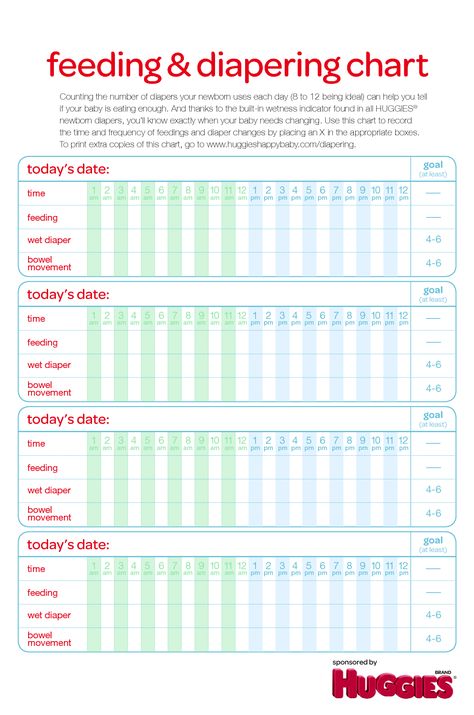 nine0003
nine0003
The child's daily routine includes the following obligatory elements: diet, time spent outdoors during the day, frequency and duration of sleep, mandatory classes to develop skills in accordance with age, free time.
In the first months after birth, a healthy newborn baby sleeps for most of the day, since all external stimuli are very strong for the nervous system of a child, accustomed to a cozy intrauterine environment, and cause its rapid exhaustion. As the child grows older, the duration of sleep gradually decreases and the time of wakefulness increases. nine0003
| Age | Daytime sleep mode | Night sleep | Wake mode |
| From birth to 2 months | 6 x 2.5 hours | 6 hours | During feeding |
| 2-4 months | 5 times 2-2.5 hours | 6.5 hours | 4 x 1.5 hours |
| 4-6 months | 4-5 times for 2 hours | 7 hours | nine0013 4 times 2 hours|
| 6-9 months | 3-4 times for 1. 5-2 hours 5-2 hours | 8 hours | 4 x 2.5 hours |
| 9-12 months | 2 x 1.5-2 hours | 9-10 hours | 4 times for 3-4 hours |
Closely related to the sleep-wake mode is the feeding mode of the baby. The sleep of a child in the first months of life is very sensitive and is easily disturbed under the influence of various extraneous stimuli, including hunger. nine0003
| Age | Mode | Example |
| From birth to 2 months | 7-8 times, every 3 hours | 6,9,12,15,18,21,24 (no night feeding) |
| From 2 to 6 months | 6-7 times, every 3.5 hours | 6, 9.30, 13, 16.30, 20, 23.30 (without night feeding) 6, 9.30, 13, 16.30, 20, 23.30, 03 (with night feeding) |
| From 7-12 months | 5 times, every 4 hours | 6,10,14,18,22 |
A child's stay in the fresh air is essential in the daily routine. The total duration of stay in the open air for children under 1 year of age should be at least 5-6 hours a day. Fresh air has a calming effect on the baby, improves metabolic processes, and increases the body's defenses. In the summer, all games and activities should be held outdoors; in the cold and transitional seasons, two one-time walks of 1.5-2 hours are provided. nine0003
The total duration of stay in the open air for children under 1 year of age should be at least 5-6 hours a day. Fresh air has a calming effect on the baby, improves metabolic processes, and increases the body's defenses. In the summer, all games and activities should be held outdoors; in the cold and transitional seasons, two one-time walks of 1.5-2 hours are provided. nine0003
Fresh air also has a beneficial effect on sleep. By acting on the skin and mucous membranes of the nose and upper respiratory tract, it provides a faster fall asleep of the child and a higher quality of sleep. Sleeping outside can replace a walk, especially during the cold season.
The child's daily routine is generally individual, but ideally, one should strive to ensure that the child eats after waking up, and then stays awake until the next sleep. A well-slept baby eats with appetite and then calmly and actively plays or engages, and tired of games, easily goes to sleep. nine0003
When your baby is awake, try to keep him active and cheerful. It is necessary to dress the child in loose clothing that does not hinder movement, provide access to toys appropriate for his age, and most importantly, actively participate in games and activities with the baby as a whole family.
It is necessary to dress the child in loose clothing that does not hinder movement, provide access to toys appropriate for his age, and most importantly, actively participate in games and activities with the baby as a whole family.
Author - Physiotherapist - DMITRIENKO T.G.
Approximate daily routine for children under 1 year old
08/21/2018
≈ 4 min reading time
We offer you an approximate daily routine. It will not be suitable for all children, but you can develop your own based on it, making some changes in it after consulting a pediatrician.
Be prepared for the fact that the baby will make its own adjustments, and some of this is not very suitable for you. It's OK. The main thing is to have something to build on. If the schedule has gone astray for reasons beyond your control, try to return to the original version. nine0003
Do not forget to include in the schedule not only sleep, feeding and walks, but also hours for games and communication with the child, as well as the time when he can be alone with himself - conditionally, of course, because such babies cannot be left unattended.
Offer your baby healthy and tasty Agusha Zasypay-ka products, which are specially designed for use before bedtime. These are live drinking yogurt with apple flavor and natural lemon balm extract, cottage cheese with strawberry, banana flavor and natural lemon balm extract, as well as cereals with prebiotics and cereals: buckwheat milk and rice milk with apple and pear, which will help your child to tune in to a healthy and deep sleep. nine0003
Baby routine 0 to 2 months
At the age of 1 - 2 months, the baby sleeps about 18 hours a day.
- 7:00 a.m. - wake up, water procedures, feeding
- 7:30 a.m. to 9:00 a.m. - awake
- 9:00 - feeding
- From 9:00 to 10:00 - the first morning dream
- 10:00 to 11:00 - active wakefulness
- 11:00 - feeding nine0149 From 11:30 to 12:30 - second morning sleep in a stroller for a walk
- 13:00 - feeding
- From 13:00 to 14:00 - active wakefulness, games
- From 14:00 to 15:00 - daytime sleep in a stroller outside during a walk
- 15:00 - feeding
- From 15:00 to 17:00 - games, wakefulness, communication
- 17:00 - feeding
- From 17:00 to 18:00 - evening sleep
- From 18:00 to 19:00 - quiet wakefulness
- 19:00 - feeding
- From 19:00 to 20:30 - communication
- 20:30 bathing
- 21:00 - feeding, night sleep
At night, you need to feed no more than 1 time in 4 hours.
2 to 3 month baby routine
At this age, the baby sleeps noticeably less: there are periods of prolonged daytime wakefulness. The first morning sleep leaves, and when the child does not sleep, he behaves more actively. Day rest is shortened. A night sleep regime is being developed: now its duration is 10-12 hours with breaks for feeding. nine0003
If this mode suits everyone and the baby does not have serious objections, then it can be used at 3 months.
- 7:00 a.m. - wake up, water procedures, feeding
- 7:30 a.m. to 9:00 a.m. - awake
- 9:00 - feeding
- From 9:00 to 10:00 - massage, special gymnastics
- From 10:00 to 11:00 - fun and games in the crib
- 11:00 - feeding
- From 11:30 to 12:30 - second morning sleep in a stroller for a walk
- 13:00 - feeding
- From 13:00 to 14:00 - you can learn to crawl
- From 14:00 to 15:00 - daytime sleep in a stroller outside during a walk
- 15:00 - feeding
- From 15:00 to 17:00 - communication with relatives or with everyone who comes to visit
- 17:00 - feeding
- From 17:00 to 18:00 - evening sleep nine0149 From 18:00 to 19:00 - reading fairy tales and poems, listening to calm music
- 19:00 - feeding
- From 19:00 to 20:30 - toys
- 20:30 bathing
- 21:00 - feeding, night sleep
4 month old baby routine
At 4 months, the baby is almost an adult.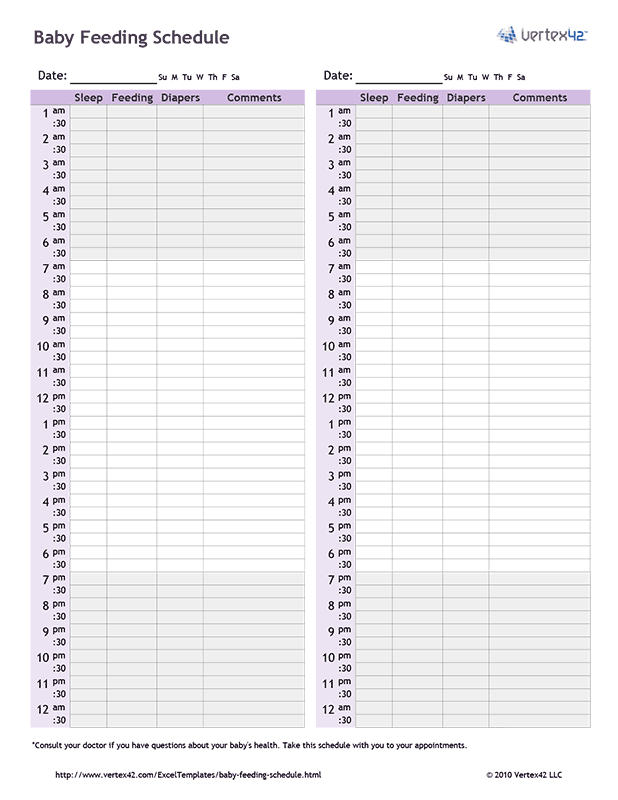 Therefore, the mode can be adjusted. First, you need to reduce the number of feedings (now this can be done every 3 or even 4 hours, depending on the needs of the child). Secondly, evening sleep ceases to be a "mandatory item on the program." At this age, it can, on the contrary, interfere with night rest. Now the child sleeps 17 - 18 hours a day. And the third thing to do is to enter the ritual of going to bed (of course, if you have not done this before). Daily baths, quiet games, lullabies and even a simple kiss goodnight will help with this. nine0003
Therefore, the mode can be adjusted. First, you need to reduce the number of feedings (now this can be done every 3 or even 4 hours, depending on the needs of the child). Secondly, evening sleep ceases to be a "mandatory item on the program." At this age, it can, on the contrary, interfere with night rest. Now the child sleeps 17 - 18 hours a day. And the third thing to do is to enter the ritual of going to bed (of course, if you have not done this before). Daily baths, quiet games, lullabies and even a simple kiss goodnight will help with this. nine0003
- 7:00 - wake up, water procedures, feeding
- 7:30 a.m. to 9:00 a.m. - awake
- 9:00 - feeding
- From 9:00 to 10:00 - massage, gymnastics
- From 10:00 to 11:30 - fun and games in the crib
- From 11:30 to 12:30 - second morning sleep in a stroller for a walk
- 13:00 - feeding
- From 13:00 to 14:00 - educational toys
- From 14:00 to 15:00 - daytime sleep in a stroller outside during a walk
- From 15:00 to 17:00 - communication
- 17:00 - feeding
- From 17:00 to 19:00 - reading fairy tales and poems, listening to calm music
- From 19:00 to 20:30 - toys or an evening walk (at your discretion)
- 20:30 bathing
- 21:00 - feeding, night sleep
5 month baby routine
The mode of sleep, wakefulness and feeding during this period is often rebuilt. Sometimes the baby can sleep through the night without getting up for feeding, or wake up very early and not go to bed in the morning. At 5 - 6 months, the baby should sleep about 16 hours a day. nine0003
Sometimes the baby can sleep through the night without getting up for feeding, or wake up very early and not go to bed in the morning. At 5 - 6 months, the baby should sleep about 16 hours a day. nine0003
- 8:00 a.m. to 8:30 a.m. - wake up, water procedures, feeding
- 10:00 - sleep
- From 11:00 to 13:00 - feeding, walking, games
- 13:00 - daytime sleep
- 14:00 - feeding, games
- From 17:00 to 17:30 - feeding, sleeping
- From 17:30 to 18:30 - games
- 18:30 bathing
- From 19:00 to 19:30 - feeding
- 20:00 - night sleep
Child's daily routine at 6 months
At the age of 6 months, the baby can wake up at night - this is due to the abundance of impressions. Parents need to calm the child, and he will quickly fall asleep again. Experts also advise putting him to bed half an hour earlier: this can reduce the number of night awakenings.
Now the time of total sleep per day is the same - about 16 hours, while there should be three daytime sleeps, 1. 5 - 2 hours each. If the baby is already teething, then he can wake up 2-3 times a night. In this case, he must be fed. nine0003
5 - 2 hours each. If the baby is already teething, then he can wake up 2-3 times a night. In this case, he must be fed. nine0003
- 7:00 - wake up, water procedures, feeding
- 8:30 - breakfast, sleep
- 10:00 - wake up, walk about 90 minutes
- 12:30 - feeding, play, sleep
- 15:00 - awakening, feeding, educational games
- 17:30 - feeding
- 20:15 - dinner, bathing, socializing
- 20:45 - night sleep
7 month baby routine
At this age and up to 9months the child sleeps about 15 hours a day. If the baby wakes up at night, talk to him quietly, calmly, and he will fall asleep again.
- 7:00 - wake up, water procedures, feeding
- 7:30 am family breakfast
- 8:30 - sleep
- 10:15 - feeding, walking
- 11:30 - lunch
- From 12:45 to 14:30 - afternoon nap, feeding, walk
- 17:15 - dinner and games
- 18:00 - feeding
- 18:30 - bathing and getting ready for bed
- 19:00 - night sleep with feeding breaks at 2:30 or 3:00 and at 4:30 or 5:00
8 month baby routine
At this age, the baby begins to painfully experience separation from his mother, so it is important to organize the child’s sleep so that he sees his mother when he wakes up.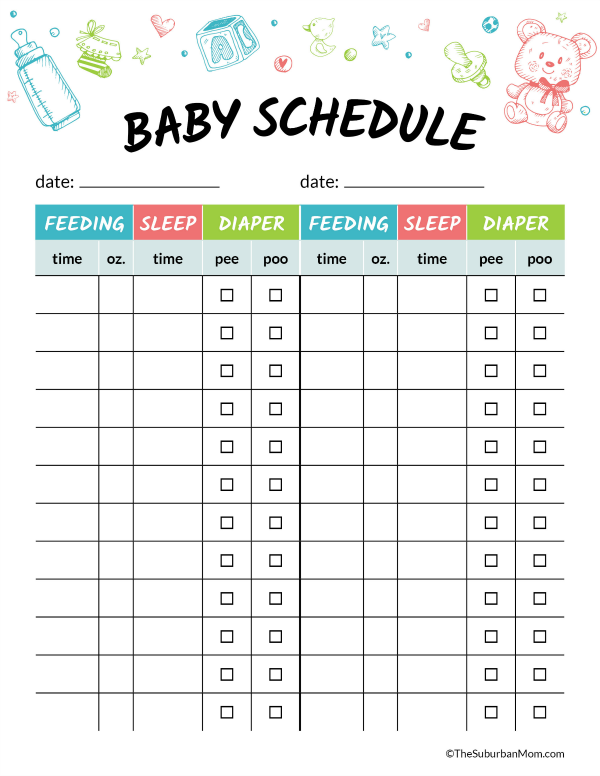
- 7:00 - wake up, water procedures, feeding
- 8:00 - first dream nine0149 9:30 - feeding
- 10:30 - games, walk
- 14:00 - feeding
- 2:15 pm - second dream
- 16:30 - games, wakefulness, communication
- 18:00 - feeding
- 18:15 - games, being awake, socializing
- 19:00 - bathing and getting ready for bed
- 19:30 - third dream
- 22:00 - feeding
- 22:15 - night sleep
Child's day routine at 9months
From 9 to 12 months, the baby, as a rule, sleeps at night for 10 - 12 hours without a break, and also 2 times a day for 1.5 - 2 hours. At this age, it is very important for him to fully restore his strength - this is of great importance for the development of the child.
- 8:00 a.m. to 9:00 a.m. - wake up, water procedures, feeding
- 9:30 am - breakfast
- 10:00 to 11:00 - games
- 11:00 - short nap
- From 12:00 to 13:00 - feeding
- From 13:00 to 14:00 - games
- 14:00 - snack
- 2:30 pm to 4:00 pm long nap
- From 16:00 to 17:00 - feeding
- 18:00 - games
- 18:30 - dinner
- From 19:00 to 20:00 - games
- 20:00 - bathing, feeding (drink)
- 21:00 - night sleep
10 month old baby routine
From 10 to 12 months, the baby sleeps about 13 hours a day, in his regime there are 2 daytime sleeps, one of which falls in the morning. nine0003
nine0003
- 7:00 - wake up, water procedures, feeding
- 8:00 am - breakfast and games
- 9:00 to 10:00 - feeding and sleeping
- 11:00 - wake up and feed
- 12:00 - lunch and games
- 13:40 - afternoon nap, feeding
- 15:30 - feeding, playing, walking
- 17:40 - lunch, games, bathing
- 19:00 - getting ready for bed, communication
- 20:00 - bathing, feeding (drink)
- 21:00 - night sleep
Child's daily routine at 11-12 months
At this age, the regime is already formed, and it is especially important to stick to it. If the baby is put to bed later than usual, he will wake up at night, sleep restlessly and will not be able to rest well.
- 7:00 a.m. - wake up, water procedures, feeding
- 8:30 - breakfast, games, reading books
- 10:00 - rest, sleep
- 11:30 - feeding, playing, walking
- 12:30 - lunch, games, books
- 14:00 - afternoon nap
- 15:00 - wake up, feed, play
- 17:30 - dinner, games
- 18:30 - rest, bathing
- 20:00 - bathing, feeding (drink)
- 21:00 - night sleep
And from the year the baby begins a new period in life, requiring a different regimen.